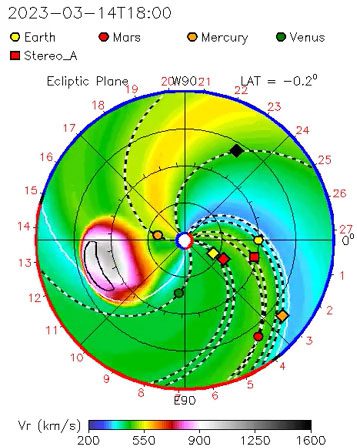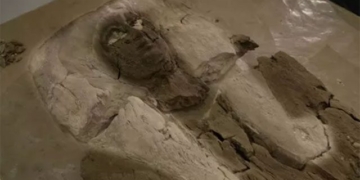A solar coronal mass ejection (CME) with an unusually high speed is likely heading straight towards the Solar Parker spacecraft, which is conducting research on the Sun for NASA.
NASA scientists discovered that the coronal mass ejection (CME) – a burst of plasma and magnetic fields from the upper atmosphere or corona of the Sun – is affecting NASA’s operational spacecraft, as reported by SciTechDaily on March 21.
Simulation showing the CME erupting from the Sun (the white dot in the center), passing Mercury (the orange dot), while Earth (the yellow dot) is on the opposite side. (Video: NASA’s Space Weather Office from the Moon to Mars).
The eruption occurred at 10:36 AM on March 13 (Hanoi time), and researchers are still collecting data to determine its origin, but it is likely from sunspot region AR3234. This region has been located on the far side of the Sun from Earth since late February to early March, releasing 15 medium-intensity M-class solar flares and one strong X-class flare.
Based on analysis from NASA’s Space Weather Office from the Moon to Mars, the CME on March 13 traveled at an unusual speed of 7,657,000 km/h, thus classified as a rare R event.
This eruption is likely to have directly impacted NASA’s Solar Parker probe. The spacecraft was nearing perihelion (the point closest to the Sun) during its 15th approach to the Sun, just 8.5 million km away on March 17. On March 13, the Solar Parker sent signals indicating it was still functioning normally. Scientists and engineers will investigate further about the eruption and its potential impacts after receiving the next data batch from the spacecraft.

This eruption, with an unusual speed of 7,657,000 km/h, is classified as a rare R event.
Even though the CME erupted from the far side of the Sun, Earth still felt its effects. As it spreads through space, the CME creates shock waves that can accelerate particles in its path to incredible speeds, similar to how ocean waves push surfers. Known as solar energetic particles (SEP), these high-speed particles can travel the 150 million km from the Sun to Earth in about 30 minutes.
Scientists typically observe SEPs following solar eruptions directed towards Earth, while eruptions from the far side of the Sun are rarer. However, Earth-orbiting spacecraft detected SEPs from the March 13 eruption, indicating the CME was strong enough to influence the side of Earth facing the Sun. NASA’s space weather scientists are still analyzing to understand how this event could have such extensive effects.





















































